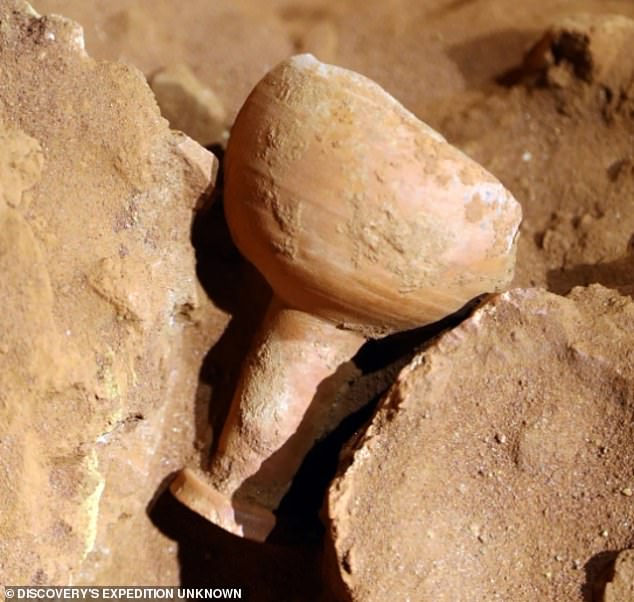In the 1989 film ‘Indiana Jones and the Last Crusade’, the Temple of the Sun is the impressive Middle Eastern shrine that houses the Holy Grail.
Now, in a case of “history imitating art,” human remains and a “Holy Grail” cup have been found beneath the real-life Al Khazneh filming location.
Experts carried out excavations beneath Al Khazneh, also known as the Treasury, an elaborate rock-cut tomb carved into a sandstone wall in Petra, Jordan.
They found a “previously unknown” grave containing 12 skeletal remains and grave goods, including a grail-shaped cup remarkably similar to the one in the film starring Sean Connery and Harrison Ford.
Experts hope that analysis of the human remains can reveal more about the Nabataeans, the ancient Arab people who built Al Khazneh.
‘Secret’ tomb at Indiana Jones filming location in Petra found to contain 12 well-preserved human skeletons

‘History imitates art’: Among the artifacts was a ceramic chalice reminiscent of the shape of the Holy Grail (pictured)

Pictured here is Indiana Jones (Harrison Ford) holding the Holy Grail in the 1989 film ‘Indiana Jones and the Last Crusade’, with Henry Jones Sr. (Sean Connery) and Sallah (John Rhys-Davies)
The excavations were led by Dr. Pearce Paul Creasman, executive director of the American Center for Research (ACOR), along with Josh Gates, host of The Discovery Channel.
Gates, who is hosting an episode of his show ‘Expedition Unknown’ from Petra, called it a ‘tremendously rare discovery.’
“In the two centuries that archaeologists have investigated Petra, nothing like it has been found before,” Gates said. cnn.
“Even in front of one of the most famous buildings in the world… there are still great discoveries to be made.”
In 2003, expeditions discovered two tombs beneath the left side of Al-Khazneh, containing partial skeletal remains.
But Dr. Creasman and his colleagues suspected there were more secret tombs waiting to be discovered.
Ground-penetrating radar, a reconnaissance technique that emits pulses of electromagnetic waves, had suggested that there were underground chambers to both the right and left of Al-Khazneh.
As a result, the Jordanian government gave ACOR permission to excavate beneath the Treasury in an attempt to prove that these additional underground chambers were really there.
The excavations, conducted in August and filmed for Expedition Unknown, found tombs filled with 12 complete skeletal remains and well-preserved bronze, iron and ceramic artifacts.

Al-Khazneh, also known as The Treasury, has appeared in many Hollywood films, including Indiana Jones and the Last Crusade (1989).

Al-Khazneh, also known as The Treasury, appeared in the 1989 film Indiana Jones and the Last Crusade. In the photo, Sean Connery and Harrison Ford.

One of the greatest monuments in the Middle East is Al-Khazneh, also known as The Treasury, located in Petra, Jordan.

Dr. Fares Braizat (from left), Fadi Balawi, Josh Gates and Dr. Pearce Paul Creasman look at the newly discovered tomb in Petra.
Petra’s humidity and seasonal flooding mean that some of the skeletons were found mouldy.
Meanwhile, among the artifacts was a ceramic chalice that strikingly resembled the shape of the Holy Grail, a notable reference to Indiana Jones.
“It really was this incredible moment in history of the imitation of art,” Gates said.
Although human remains have already been found inside tombs under Al-Khazneh, such discoveries are rare, according to experts.
“The burials in this grave are hinged, so the bones have not been picked or moved, which is extremely rare,” Dr Creasman said.
It is believed that this is the largest collection of humans in one place in Petra and that there is still more to discover beneath the monument.
Given their prime location beneath the legendary rock-cut building, Dr Creasman believes these were “enormously important people” in their time.

Although human remains have already been found inside tombs in Al-Khazneh, such discoveries are rare, according to experts.

In the 1989 film ‘Indiana Jones and the Last Crusade’, the Temple of the Sun is the impressive Middle Eastern shrine that houses the Holy Grail. The exterior scenes were filmed in Al Khazneh, but the interior temple scenes were filmed at Elstree Studios in England (pictured).
They would have been the Nabataeans, the ancient Arab people who inhabited northern Arabia and the southern Levant.
During its heyday around the birth of Christ, the Nabataean Empire spread throughout the Middle East to include Jordan, Israel, Egypt, Syria, and Saudi Arabia.
Things changed drastically for the Nabataeans and Petra around 106 AD. C., when the Romans peacefully took control of Petra (the capital of the kingdom) and the entire Nabataean people.
Once a thriving commercial center, Petra is located in what is now the southwestern corner of the Hashemite Kingdom of Jordan.
Today, Al Khazneh’s distinctive carved building attracts almost a million tourists a year.
Although the exterior statues have been badly eroded by wind and rain, visitors can still see mythological figures related to the afterlife, including four eagles that carry away the souls of the dead.
The team emphasizes that no skeletal remains have been found inside the building itself, which was probably built in the 1st century AD as a mausoleum and crypt.
Experts will now analyze the remains in the hope of learning more about their lives, including their professions, eating habits and age at death.


